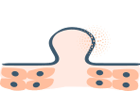Ammash, N., Sundt, T., & Connolly, H. (2008). Marfan Syndrome—Diagnosis and Management. Current Problems In Cardiology, 33(1), 7-39. doi: 10.1016/j.cpcardiol.2007.10.001
Dietz, H., Cutting, C., Pyeritz, R., Maslen, C., Sakai, L., & Corson, G. et al. (1991). Marfan syndrome caused by a recurrent de novo missense mutation in the fibrillin gene. Nature, 352(6333), 337-339. doi: 10.1038/352337a0
Yuan, S. M., & Jing, H. (2010). Marfan’s syndrome: an overview. Sao Paulo medical journal = Revista paulista de medicina, 128(6), 360–366. https://doi.org/10.1590/s1516-31802010000600009
Dean J. C. (2007). Marfan syndrome: clinical diagnosis and management. European journal of human genetics : EJHG, 15(7), 724–733. https://doi.org/10.1038/sj.ejhg.5201851
Pyeritz R. E. (2019). Marfan syndrome: improved clinical history results in expanded natural history. Genetics in medicine : official journal of the American College of Medical Genetics, 21(8), 1683–1690. https://doi.org/10.1038/s41436-018-0399-4
Robinson, P. N., & Godfrey, M. (2000). The molecular genetics of Marfan syndrome and related microfibrillopathies. Journal of medical genetics, 37(1), 9–25. https://doi.org/10.1136/jmg.37.1.9
von Kodolitsch, Y., & Robinson, P. N. (2007). Marfan syndrome: an update of genetics, medical and surgical management. Heart (British Cardiac Society), 93(6), 755–760. https://doi.org/10.1136/hrt.2006.098798






